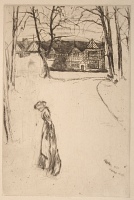Etchings Institutions search term: gutekunst
Speke Hall: The Avenue | ||
| Number: | 101 | |
| Date: | 1870-1878 | |
| Medium: | etching and drypoint | |
| Size: | 228 x 152 mm | |
| Signed: | 'Whistler' at lower right (1-12); butterfly lower left (11-12); both removed (13-final) | |
| Inscribed: | '1870. / Speke Hall.' at lower right | |
| Set/Publication: | no | |
| No. of States: | 14 | |
| Known impressions: | 22 | |
| Catalogues: | K.96; M.95; W.86 | |
| Impressions taken from this plate (22) | ||

The copper plate bears the oval stamp of 'HUGHES & KIMBER / MANUFACTURERS / LONDON E.C.' on the verso. Hughes & Kimber were the coppersmiths most favoured by Whistler. This is the stamp found on twelve surviving copper plates that were etched between 1870/1873 (Speke Hall: The Avenue, The Silk Dress
[151], Reading a Book
[112], The Beach, Hastings
[150],
Tillie: A Model
[113], Resting
[111], Miss Alexander
[117], The Guitar Player (M.W. Ridley)
[124],
The Piano
[144],
Shipbuilder's Yard, Liverpool
[142], London Bridge
[172], and Little Smithfield
[154]). Two of these are Leyland/Speke Hall subjects (Speke Hall: The Avenue and Shipbuilder's Yard, Liverpool
[142]). Two of the plates are 127 x 77 mm (Reading a Book
[112], Resting
[111]) and five are 159 x 235 mm
(Reading a Book
[112], The Beach, Hastings
[150],
Tillie: A Model
[113], Miss Alexander
[117] and
The Piano
[144]).
The size of copper plate used for Speke Hall: The Avenue, was produced by Hughes & Kimber over a long period, and was much used by Whistler. Hughes & Kimber plates, of similar size, but with a rectangular stamp, are found on Mrs Leyland, Sr.
[123] and on slightly later etchings, such as Maud, Standing
[169] and Nude Woman Standing, hand on hip
[114]. Furthermore, a third group of Hughes & Kimber plates, of similar size, was used both earlier and later (Landscape with Fisherman
[85], Pickle Herring Wharf
[164]).
The copper plate of Speke Hall went through many revisions over a long period, and shows signs of this, with pitting, particularly at the top edge, and hammer-marks and scoring on the verso.
The plate was given by Rosalind Birnie Philip (1873-1958) to the University of Glasgow in 1935. It is not known if she inherited it from Whistler or if it was sold at the time of his bankruptcy and later retrieved by her from the London print dealer Robert Dunthorne (b. ca 1851). It was cancelled posthumously with a diagonal line from upper left to lower right.
